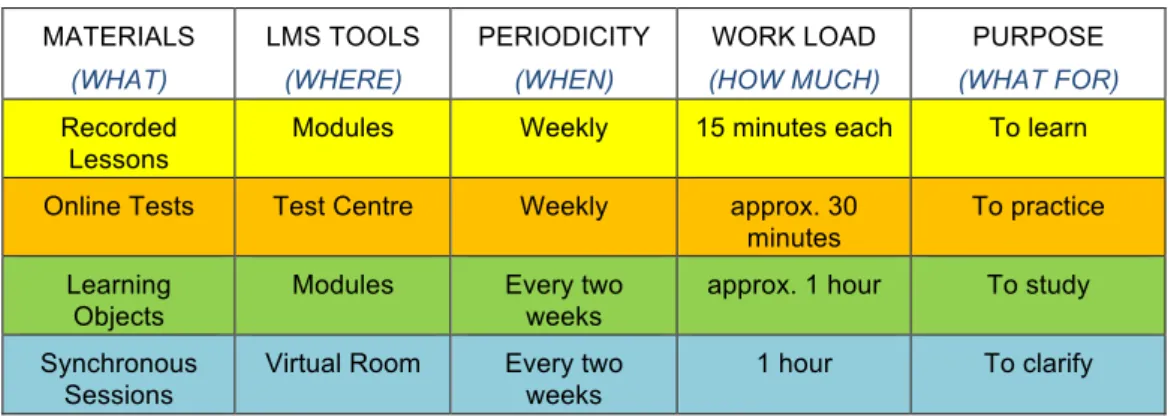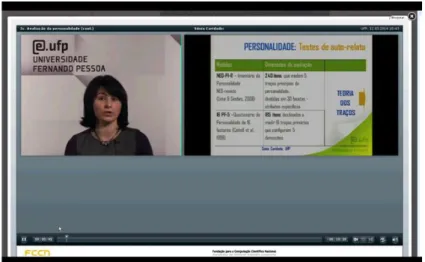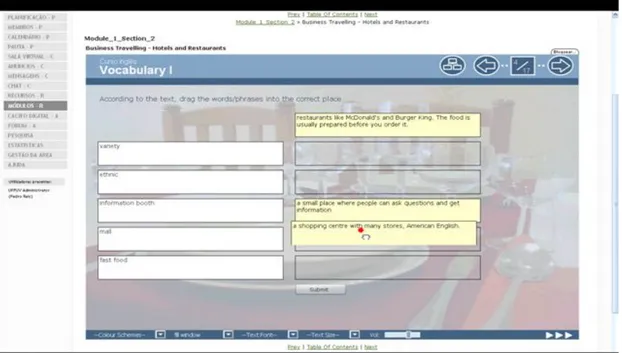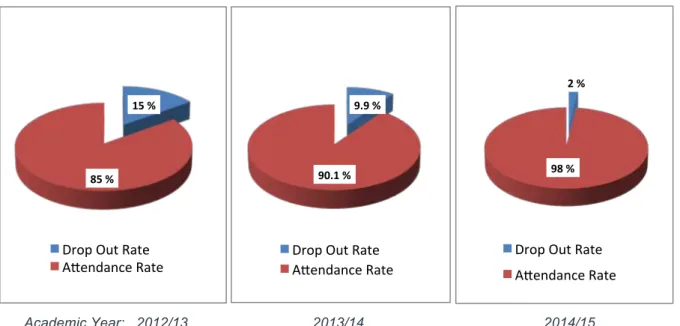E-LEARNING COURSES AT UFP-UV – POTENTIAL AND
CHALLENGES
Pedro Reis, Fátima Silva
Universidade Fernando Pessoa (PORTUGAL)
Abstract
This paper deals with the challenges related to the e-learning experiences at Fernando Pessoa University (Porto, Portugal). After approximately 30 years of on-site courses, in 2012, the decision was made at the university to offer distance courses as well.
This decision represented a huge challenge at various levels. Training faculty for teaching at a distance became necessary; thus, a training program was implemented, focusing on methodological, pedagogical and technological aspects. A specific regulation was also set up to clarify essential rights and duties of faculty and students and the assessment rules. This document ensures the application of specific teaching methods. All this takes place in a virtual campus - UFP-UV - equipped with educational technologies. Thus, in a LMS, recorded lessons, learning objects, and synchronous sessions in a virtual room are combined into a methodology that also focuses on continuous assessment, using written and oral assignments, challenging tasks, and regular synchronous and asynchronous contacts between teachers and students in small groups. In order to support faculty and students, a help desk devoted exclusively to this function was also created.
Hence, since 2012, about 300 national and international students have attended e-learning courses at UFP, in Portuguese, English, or Spanish. The dropout rate, one of the most common concerns about this regime, has been, so far, residual. At the end of each term, surveys are sent to students in order to know their rate of satisfaction. Following the analysis of the surveys, we seek to strengthen the aspects identified as positive, and correct aspects identified as less positive.
So, in this paper we will also focus on the analysis of quantitative and qualitative data which helps to critically analyze the process.
Keywords: e-learning courses, virtual university, challenges, critical analysis.
1
INTRODUCTION TO THE NATURE OF THE TEACHING/TRAINING
INITIATIVE AND ITS SPECIFIC OBJECTIVES
After approximately 30 years of on-site courses, in 2012, the decision was made at University Fernando Pessoa (UFP) (Porto, Portugal) to also offer distance courses.
The offer, which existed as such from 2012 to 2015, included courses of first cycle (Undergraduate), second cycle (Master) and third cycle (PhD). These were mostly from the Faculty of Human and Social Sciences, including undergraduate courses such as Communication Sciences, Business Sciences, Business Management and Accounting, Criminology, Political Science and International Relations, Psychology, Social Work, and master courses such as Creativity and Innovation; Humanitarian Action, Cooperation and Development; Clinical and Health Psychology; Legal Psychology, Teaching and Management of Education, and PhD in Information Sciences.
There were also post graduation courses (for instance, Facial Expression of Emotion) and training courses (for instance, Business English - elementary and intermediate).
Moreover, there were also other courses in blended-learning from different academic fields, namely Health Sciences and Technology, such as Nursing and Computer Sciences, respectively.
Hence, between 2012 and 2015, about 300 national and international students were attending e-learning courses at UFP, in Portuguese, English, or Spanish.
only some blended-learning courses. This paper intends to be a brief account and evaluation of the initiative of introducing distances courses at the institution level from 2012 to 2015.
2
THE INFRASTRUCTURE I.E. PEOPLE, SYSTEMS, HARDWARE, SOFTWARE
ETC. REQUIRED TO LAUNCH THE INITIATIVE
The implementation of Distance Education courses at UFP implied the creation of a new department, named UFP-UV (Universidade Virtual, that is Virtual University), a very light structure where a Pedagogical Coordinator, two other permanent full-time collaborators (one for user support and content management and another one for technical support and development), and also some occasional trainees provided specific services to about 300 students and 80 faculty, involved in this project.
The e-learning courses at UFP-UV used a Learning Management System (LMS) which is Sakai.
Projected by educators for educators, Sakai is a digital learning/teaching and academic collaboration environment which we customised to meet our needs and corporate image.
The Sakai community is comprised of individuals and institutions that share a common commitment to enhancing teaching, learning and research. This commitment is reflected in how community members come together to pool knowledge, define the needs of academic users, create and share software tools, and support adoption of the Sakai project. Participation from more than 350 of the world’s leading institutions lends creativity, stability and longevity to this effort. (https://sakaiproject.org/ community)
In 2009, the UFP-UV team won the award Sakai fellow of the year, for the contributions made to the community of users, particularly with the creation of a tool, Site Stats, to see statistics and create field activity reports.
Although this open source LMS is the basis of the virtual campus, other open source educational technologies were added in an integrated approach. Thus, students did not have to leave the UFP-UV Campus to attend their courses. Here, they found all the resources used in the teaching-learning process: different tools of the LMS, especially for written asynchronous activities; the Virtual Room, for synchronous oral contacts; the videos of the recorded lessons from their teachers; and the Learning Objects (LOs), each having a main pedagogical goal.
Table 1. UFP-UV standard e-learning methodology
MATERIALS (WHAT) LMS TOOLS (WHERE) PERIODICITY (WHEN) WORK LOAD (HOW MUCH) PURPOSE (WHAT FOR) Recorded Lessons
Modules Weekly 15 minutes each To learn
Online Tests Test Centre Weekly approx. 30
minutes
To practice
Learning Objects
Modules Every two
weeks
approx. 1 hour To study
Synchronous Sessions
Virtual Room Every two weeks
1 hour To clarify
Figure 1. Screenshot of a Recorded Lesson.
(More at: http://www.ufpuv.com/tecnologias-educativas/educast/?lang=en)
Figure 2. Recorded Lessons at UFP-UV (2012-2015). (Total number of videos recorded in this period: 1175)
The Virtual Room is called COLIBRI, a Web Collaborative Environment. With the COLIBRI service, users can have video conference sessions for multiple purposes (lessons, webminars - sometimes with invited lecturers from other universities -, tutorial sessions, dissertation supervision, meetings among students for group work). It includes features such as live quizzes, screen or file sharing and mobile devices access. It is also cross browser compatible.
The Virtual Room is also integrated with the LMS (Sakai). Students could attend lessons and webminars live or see them after they take place, since they were all recorded. So, students with professional commitments, for example, who could not attend those live lessons or webminars, had the option to see them later, and thus became aware of what had been discussed. For those who participated, they could also review the lessons as a study strategy. The synchronous sessions in the Virtual Room provided moments of clarification, reflection, discussion or synthesis of subject matters.
0000 0050 0100 0150 0200 0250
5 66
13 228
30 14
102 182
57 30
91 182
54 32
89
Number of
videos
Scien1fic Field
Figure 3. Screenshot of the Virtual Room.
(More at: http://www.ufpuv.com/galeria-sala-virtual/?lang=en)
Some LOs were produced using freeware authoring tools, such as eXe Learning, CourseLab, and especially Xerte (a fully-featured e-learning development environment for creating web content, with enriched media and rich interactivity). With licensed software, more sophisticated LOs could eventually be produced, but we had to consider both budget restraints and the long learning curve necessary to achieve proficiency with that kind of software which is hard to conciliate with rapid learning development. This led us to choose, at that time, easy-to-use, yet relatively powerful, e-learning authoring tools which offer programming-free WYSIWYG environment for creating interactive e-learning content which could be published in our LMS. In spite of this effort, we recognize that the creation and development of LOs is one of the fields where our activity could improve, as I will mention later.
Figure 4. Screenshot of a Learning Object.
3
THE CHALLENGES THAT WERE ENCOUNTERED, HOW THEY DEVELOPED
AND HOW THEY WERE OVERCOME
Although great care was placed in the support technologies, and pedagogical models were inspired by international best practices [2], [3], [4], [5], [6] adapted to our reality and carefully transmitted and discussed with teachers, the doubt persisted if the players would adapt to and master the technological solutions and if the methodology was appropriate.
At the beginning of this implementation process, the aim was to give it an operational facet, in order to make this teaching and learning process, new at the university, as comprehensible as possible to everybody involved (faculty, students and also some administrative staff). We were well aware of how challenging it was to have an approach which would be able to cover a significant number of people, knowing inclusively that the public would be heterogeneous, at the level of IT skills, for example. Additionally, this proved to be true not only for students but also for teachers, who, belonging to different generations and having different scientific backgrounds, naturally have very heterogeneous levels of computer skills. Thus, continuous training and especially permanent support were crucial to the project. Training and support to teachers was provided mostly F2F, at the university e-learning department, and support to distance students was provided in various forms: e-mail, phone, Skype and also original tutorials produced at the department and sent by email or delivered on the LMS.
The training program for faculty focused on methodological, pedagogical and technological aspects [7]. One of the biggest challenges, at first, was indeed the fact that teachers were not prepared for e-learning. This required very personalized training, in small groups, within the same scientific field to better realize and share the difficulties that e-learning could represent to each group. This was complemented by constant assistance from a help desk devoted exclusively to this function.
In the implementation of our e-learning comprehensive methodology, we had to insist with faculty that it would take place exclusively on the Virtual Campus of the university, which is equipped with appropriate state of the art educational technologies suitable for this purpose. This would guarantee that students would effectively have online courses, and furthermore it would be a guarantee both for teachers, since their work would be documented, and also for the university, whenever it is necessary to demonstrate to national and international educational authorities how our e-learning courses work and what has been done.
So, other general ways of communicating with students, by email or Skype, for example, are not prohibited, of course, but those are not to be confused with the official teaching-learning process. The latter occurs exclusively on the Virtual Campus of the university, whereas other contacts by email or Skype have to be seen only as informal communication, as the equivalent to a corridor or cafeteria contact in an on-site context. Thus, training of faculty, in addition to focusing on the specific training in the use of new technological educational tools, consisted also on a kind of evangelization for the assimilation of a new teaching paradigm.
4
HOW THE INITIATIVE WAS RECEIVED BY THE LEARNERS AND OTHER
PARTICIPANTS
(More statements at: http://www.ufpuv.com/recursos/o-que-dizem-os-nossos-alunos/?lang=en)
Following the analysis of the surveys, we sought to strengthen the aspects identified as positive, and correct aspects identified as less positive. This contributed to the commitment we assumed with ourselves, with the university, with our students and with potential candidates: the commitment to do better. We perceive experience, not as an accumulation of repeating procedures, but as the result of reflection and critical analysis of our practice, in order to establish continuous improvements. The analysis of quantitative and qualitative data from the inquiries led us to consider this initiative as a major challenge, with many improvements still to be introduced, but also that we were likely to be on the right track [8].
One good sign was, for example, the dropout rate, one of the most common concerns about this regime, which was residual in our courses.
Academic Year: 2012/13 2013/14 2014/15
Figure 5. Dropout Rate at UFP-UV from 2012 to 2015
15 %
85 %
Drop Out Rate A8endance Rate
9.9 %
90.1 %
Drop Out Rate A8endance Rate
2 %
98 %
Drop Out Rate
5
THE LEARNING OUTCOMES THAT WERE ACHIEVED AND HOW THEY
WERE MEASURED AND EVALUATED
We opted for a solid and demanding pedagogical model that would allow us to control the learning progress, the work done, and the skills developed in a continuous way and even different behaviours inherent in cognitive styles, in the different dimensions of emotional intelligence and in the interaction and group cohesion.
As stated before, the model had three main components: theoretical recorded classes, live online classes and challenging assignments. With the video recordings students became familiar with their teachers whom they get used to seeing and hearing. With regular synchronous sessions in the virtual room, students came into direct contact with teachers and classmates creating a sense of belonging, participation and familiarity not far from what happens in a F2F course.
Original documents were produced by our department to assist the implementation of this modality and to guide stakeholders: terms of admission and regulation of attendance for students; storyboards (for faculty to provide content for the development of LOs); and a planning to guide teachers to determine the syllabus of the courses basically in terms of objectives and competences; contents organised in modules and topics, the methodology (materials – i.e. video recordings and LOs - and the activities), the estimated number of hours for activities, recordings and synchronous sessions, and the assessment criteria.
The courses were organised in the Unit/Module/Topic (UMT) approach [6]. Typically, a semestrial course had 2 or 3 modules, and each module had 3 to 5 topics, and each topic is associated with one learning outcome. Teachers produced video recordings of approximately 15 minutes for each topic. This methodology provided guidance both to teachers (as they knew more precisely what they had to transmit to students) and also to students (since they received gradually the content for each subject). This organization of the courses ensured that teachers approached and, consequently, students received information about all the subjects of the syllabus.
A specific regulation was also set up to clarify essential rights and duties of faculty and students and the assessment rules. This document ensured the application of a specific teaching method with a view to developing efficient skills in the teaching-learning process.
The elements of assessment ideally covered all the topics of the modules and could be materialized in several formats (written assessments, challenging tasks, research work, critical reading, participation in discussion forums, collaborative work, oral presentations, among other possibilities).
The attendance regime forced students to participate in at least 50% of the synchronous sessions, which ensured that teachers would have the opportunity to know their students and maintain a minimum of regularity in synchronous contacts.
The assessment rules included compulsory synchronous contacts, like oral presentations in the virtual room, to be worth at least 30% of the final grade, in order to contribute to the credibility of the assessment system, because in a synchronous session in the virtual room there was no doubt about the identity of the students, and they were confronted with direct questions from teachers when they were making an oral presentation, oral assessment or discussing a topic. All assessment sessions (oral and written) were recorded for file registration purposes.
Guidance of students’ pedagogical activities was based on progress, aspects which could be improved, and the development of competences. Considering teaching strategies, we valued collaborative work, since students were not competing; on the contrary, they were collaborating in the pursuit of a common goal. As a consequence, this tended to increase the motivation, and since each student knew that a project would be incomplete and fail if their contribution was missing, this also tended to increase the sense of accountability to perform these tasks. The assessment of distance education programs essentially checked the compliance with the learning objectives set out for each course and gave preference to student contributions in acquiring competences.
6
PLANS TO FURTHER DEVELOP THE INITIATIVE
We are well aware that not all scientific areas and not all education levels equally adjust to the development of multimedia and interactive LOs. Furthermore, not all teachers have the same ability to interact with Instructional Designers, in order to convert their working materials to e-learning formats.
However, as was the case with the adoption of an e-learning platform to complement F2F classes since 2004, when the good practices of some teachers began to be known and appreciated by the community, students started asking teachers, who were not yet using the platform, to begin to use it so as to provide materials, schedule activities, allow assignment submissions, etc. So, in this case, the former good examples excited students who pushed other teachers to adopt those good practices. We hope that something similar may happen with e-learning courses, because when some courses provide students with attractive materials, creating a certain level of expectation, this will certainly lead them to ask for a similar level of teaching materials from other courses.
So, we plan to encourage the use of diversified learning materials to make the courses more appealing, taking into account the adequacy of those materials to the nature of subject matters and the learning outcomes of each level (1st, 2nd or 3rd cycle).
Another keystone in an e-learning system is the assessment scheme. We are well aware that the online assessment system is not infallible, but, on the other hand, is there any system that can be considered as such? However, our efforts are focused on looking for solutions that offer more guarantees to ensure the credibility of the courses, which we consider a key factor to uphold. In our project, written exams were conducted online, via Virtual Room, using application sharing, with remote supervision of the teacher. The audio and video channels both of the student and the teacher had necessarily to be open. Actually, the use of webcam by the student was mandatory, otherwise the exam could not take place. In order to further improve these guarantees, we consider introducing changes in the future, such as adding software that helps to ensure the identification of students in the written tests; or eventually establishing partnerships with foreign higher education institutions or protocols with official entities (embassies, consulates) where international students can go to take written tests and exams.
REFERENCES
[1] P. Reis. e-Learning in the Portuguese Educational Context in Trends and Issues in Distance Education: International Perspectives (L Visser, Y. Visser, R. Amirault & M. Simonson eds.), pp. 230 - 242. Charlotte, North Carolina: Information Age Publishing, 2012.
[2] C. J. Bonk, & K. Zhang. Empowering Online Learning: 100+ Activities for Reading, Reflecting, Displaying and Doing. London: Jossey Bass, 2008.
[3] B. Kahn. Managing e-Learning Strategies Design, Delivery, Implementation and Evaluation. Hershey, London, Melbourne, Singapore: Information Science Publishing, 2005.
[4] G. Kearsley. Online education: Learning and teaching in Cyberspace. Belmont, CA: Wadsworth Publishing Company, 2000.
[5] J. R. Lagarto et al. Guia para a Concepção e Desenvolvimento de Projectos de Formação a Distância. Lisboa: INOFOR, 2003.
[6] M. Simonson, S. Smaldino, M. Albright, & S. Zvacek, Teaching and Learning at a Distance: Foundations of Distance Education. 4th ed. Boston: Allyn and Bacon, 2008.
[7] P. Reis & F. Silva (eds.) Cibertextualidades 4 e-Learning: Desafios Pedagógicos / Pedagogical Challenges. Porto: Fernando Pessoa University Editions, 2011.



